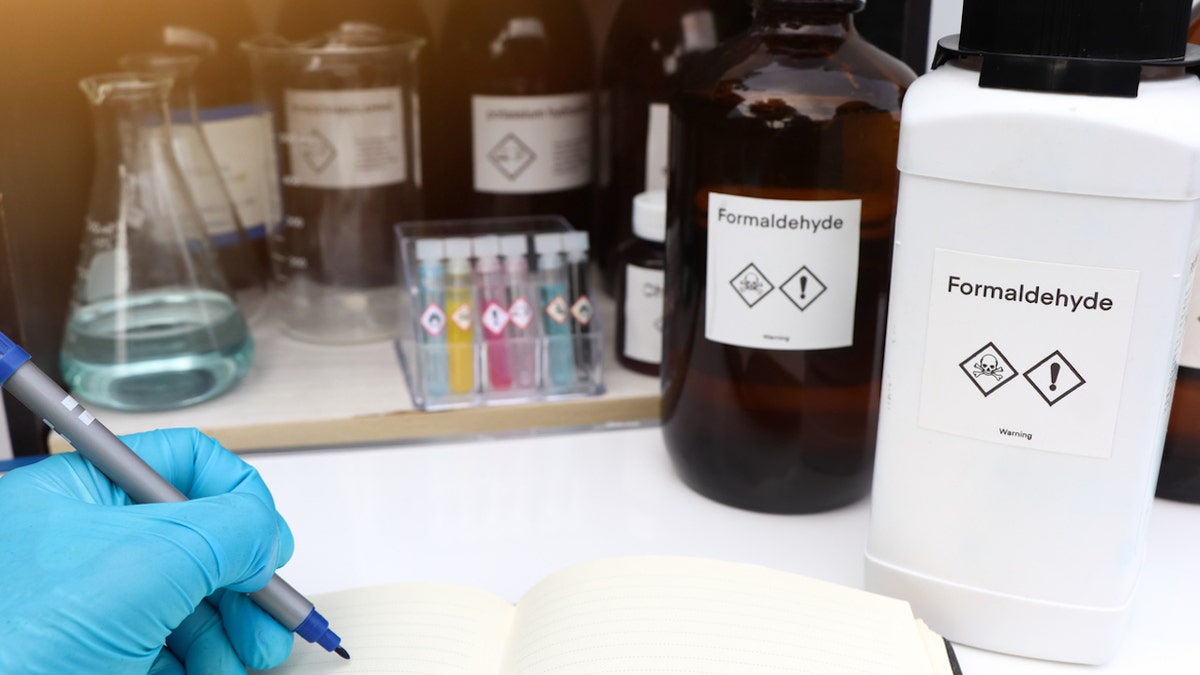New York Auto Show exclusive look at 2024 cars
‘Fox & Friends Weekend’ co-hosts take a look at the Lexus RZ 450 Electric, the Ram 1500 Rev Bev concept and other hot new vehicles with auto expert Mike Caudill.
There's just nothing like that "new car smell," many people believe.
There is a health angle to consider, though. A recent study by the Beijing Institute of Technology and the Harvard T.H. Chan School of Public Health, published in the journal Cell Reports Physical Science, found that the cabin of a new vehicle contained 20 common "volatile organic compounds" (VOCs), which could potentially contain cancer-causing agents.
The Environmental Protection Agency defines VOCs as "compounds that have a high vapor pressure and low water solubility," which are found in paints, pharmaceuticals and petroleum fuels.
In particular, the study found high levels of formaldehyde (34.9%) and acetaldehyde (60.5%) inside a new car.
MORE THAN 24,500 CHEMICALS FOUND IN BOTTLED WATER
To get these results, the researchers used sensors to test the chemical content inside a new car that was "airtight" (all windows and doors closed) and parked outside for a 12-day period. The tests were conducted at different temperatures and humidity levels.
"The risk assessment showed a high incremental lifetime cancer risk for drivers exposed to some chemicals through inhalation, ingestion and dermal uptake," study author Dr. Jianyin Xiong, director of the Institute of Thermal Engineering at the Beijing Institute of Technology, told Fox News Digital via email.

In a study, the cabin of a new vehicle (not pictured) contained 20 common "volatile organic compounds" (VOCs), which could potentially contain cancer-causing agents. (iStock)
The researchers were surprised to find that in direct sunlight, the surface temperature of the car’s dashboard could reach up to 196 degrees Fahrenheit.
"The in-cabin chemical emissions depended on the material surface temperature rather than the widely used air temperature," Xiong explained. Higher temperatures correlated with higher amounts of chemicals, researchers found.
'FOREVER CHEMICALS' IN WATER AND PACKAGING CAN RISK HEALTH, EPA SAYS
The study author said researchers used a "new midsize SUV (hybrid electric vehicle), which was made in 2022."
Fox News Digital reached out to Toyota, Honda, Hyundai and the Alliance for Automotive Innovation for comment.
Do in-car chemicals pose a health hazard?
Dr. Kelly Johnson-Arbor, medical toxicologist and co-medical director of the National Capital Poison Center in Washington, D.C., explained that VOCs are gases that are released into the air from products such as furniture, fabrics and chemicals — and they’re also responsible for the "new car smell" that is present in factory-fresh vehicles.
She was not involved in the study.
Higher temperatures correlated with higher amounts of chemicals.
"Some VOCs, including formaldehyde, are associated with adverse health effects in humans," she said.
In testing the new car’s interior, the concentrations of some chemicals — notably formaldehyde and acetaldehyde — were found to be several times higher than the standard limit.

The study found high levels of formaldehyde, a chemical that has been linked to certain types of cancers, inside the new car. (iStock)
Formaldehyde is a colorless, flammable gas that is used to make home-building products and is found in automobile exhaust.
The Environmental Protection Agency (EPA) considers it to be a "probable human carcinogen," as some human studies have shown a link between formaldehyde exposure and lung and nasopharyngeal cancer.
Acetaldehyde is an organic chemical compound that is used to make polyester resins, perfumes and dyes, per the EPA. It is also often used to create other chemicals.
Like formaldehyde, it is considered a "probable human carcinogen" based on some human and animal studies.
The level of chemical exposure diminishes over time as the car is used.
"People who breathe in formaldehyde or acetaldehyde at these levels for short periods of time may experience irritating symptoms affecting the eyes, lungs, nose and throat," said Johnson-Arbor. "Some people are more sensitive than others and may experience headaches, dizziness or trouble breathing."
If inhaled over longer periods of time, those vapors may also be associated with an increased risk of cancer development, she added.
CHEMICALS IN WATER AND HOUSEHOLD OBJECTS COULD REDUCE CHANCES OF PREGNANCY, LIVE BIRTHS: NEW STUDY
"However, since driving involves opening and closing car doors on a regular basis, it’s unlikely that formaldehyde, acetaldehyde or other VOCs will build up consistently in high enough amounts to cause cancer in people who drive new cars," Johnson-Arbor said.
Preventing new car hazards
Based on the findings of the study, Xiong suggests that vehicle designers choose more environmentally friendly interior materials and take steps to reduce in-cabin air quality.
While consumers can’t choose the materials used in the production process, they can use air purifiers inside the car and open ventilation or windows while driving if weather permits, he added.

"The in-cabin chemical emissions depended on the material surface temperature rather than the widely used air temperature," the study author said. Researchers also said the conditions inside the car are "very complicated." (iStock)
It’s also important to note that the level of chemical exposure diminishes over time as the car is used.
"While the presence of VOCs in new car interiors is concerning because of the potential effects on human health, the concentration of VOCs in new cars does decrease over time as natural driving activity leads to ventilation of the car’s interior — so it’s unlikely that most people who purchase new cars will experience significant adverse health effects from breathing in the ‘new car smell,'" Johnson-Arbor explained.
CHATGPT AND HEALTH CARE: COULD THE AI CHATBOT CHANGE THE PATIENT EXPERIENCE?
For people who are particularly sensitive to smells, she suggests thoroughly ventilating a vehicle before driving it, especially on hot summer days when VOC emissions are higher.
"As shown in this study, this can be achieved by opening doors and windows for just under half an hour prior to driving the vehicle," said Johnson-Arbor.
Study had limitations, researchers said
While the researchers are confident in the accuracy of their measurements inside the new, airtight car that was used in the study, they described the conditions inside the car as "very complicated."
CLICK HERE TO SIGN UP FOR OUR HEALTH NEWSLETTER
Temperature and other factors impacting the chemical emissions may differ in various scenarios, such as driving or having the windows open, Xiong pointed out.
The findings may also vary across different vehicles.
CLICK HERE TO GET THE FOX NEWS APP
"These factors may lead to some bias when using our prediction model in realistic conditions," he told Fox News Digital.


